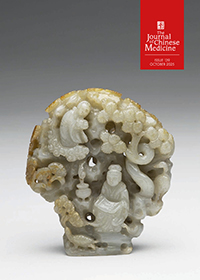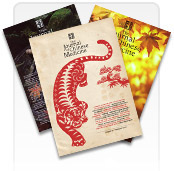We use cookies to make your experience better. To comply with the new e-Privacy directive, we need to ask for your consent to set the cookies. Learn more.
Latest Issue
Latest issue no. 139 - Oct 2025

Features & Articles in this issue
Editorial
Author: Daniel Maxwell
I have seen a lot written recently about how to market acupuncture effectively. One popular strategy dispenses with traditional Chinese medical terminology to communicate in the language of the masses. This means out with qi, yinyang and wuxing and in with modern terms that Joe/Josephine Public can - quite literally - buy. Some acupuncturists go the whole hog, presuming that our poor primitive Chinese forebears made up qi and the channels to describe something they did not - and could not - identify or understand: oxygen and nerves. Talk about throwing the invisible baby out with the materialistic bath water. Some practitioners choose to avoid all such shop-talk in clinic, presuming that the outlandishness of such 'trad' language might alienate patients. Of course, dumbing things down for public consumption is de rigeur today. A huge proportion of our potential patients - particularly those under 30 - engage with the world exclusively through Tik-Tok , Instagram or Twitter / X which, let’s face it, are not known for their nuance and depth.
The Treatment of Gout and Hyperuricaemia with Traditional Chinese Medicine
Author: Peilin Sun
This article integrates modern medical perspectives on hyperuricaemia and gout with the holistic principles and syndrome differentiation of traditional Chinese medicine (TCM). Hyperuricaemia is examined as a metabolic and systemic imbalance. The pivotal roles of the Spleen, Liver and Kidney in pathogenesis and treatment are emphasised. This includes an in-depth analysis of key pathological mechanisms such as damp-heat, qi stagnation and blood stasis. Highlighting TCM’s personalised and prevention-oriented approach, comprehensive therapeutic strategies are outlined including acupuncture, herbal medicine and lifestyle modification, providing innovative theoretical insights and practical clinical guidance for managing hyperuricaemia, gout and other associated conditions such as metabolic syndrome.
Bringing Qi into our Actions
Author: Stephen Birch & Miguel Angel Cabrer Mir
This article explores qi in Chinese medicine, tracing its cosmological and practical significance. It highlights how a practitioner’s cultivated body-mind state is essential for effective needling and presents the concept of you - fluid, spontaneous action aligned with the flow of qi. It is excerpted from the second edition of Restoring Order in Health and Chinese Medicine, published in June 2025 by Sayoshi Books.
Fu Zheng Hua Yu Wan (Support the Upright and Dissolve Stasis Pill) for Complex Cardiohepatic Disease: A Case Study
Author: Justin Penoyer
This case involves a 57-year-old female with a five-year history of severe, chronic cardiovascular, liver and fluid regulation dysfunction that included cardiomegaly, atrial fibrillation, tachycardia, high blood pressure, chronic pitting oedema, ascites, cirrhosis and portal-vein regurgitation. Previous conventional medical treatments failed to control her symptoms, prompting her to seek traditional Chinese medicine. After multiple ineffective attempts at diagnosis and treatment, introducing Fu Zheng Hua Yu Wan (扶正化瘀丸, Support the Upright and Dissolve Stasis Pill) proved pivotal. After four months of treatment the patient experienced significant improvements in heart function, liver health, oedema and vitality. These results underscore the effectiveness of a targeted approach rooted in classical Chinese medicine.
Does Acupuncture Influence the Human Gut Microbiome? A Critical Review
Author: Pippa Glendon-Doyle
This article is a critical review that evaluates whether acupuncture has a statistically significant effect on bacterial diversity and/or microbial composition in the human gut. Of the 213 papers retrieved from a systematic literature search, three randomised controlled trials (RCTs) on acupuncture for subjects with Parkinson’s disease, Crohn’s disease and simple obesity were identified for appraisal using CONSORT (Consolidated Standards Of Reporting Trials) / STRICTA (Standards for Reporting Interventions in Clinical Trials of Acupuncture) guidelines. The article concludes that although there is insufficient evidence that acupuncture influences diversity within the human gut microbiome, it may have a modulating effect on bacterial composition, elevating levels that are reduced and reducing levels that are elevated within the conditions studied. However, due to the limitations in the evidence available, more research is required and therefore suggestions are made for future research design.
The Wisdom of Not Knowing: Embracing Diagnostic Discomfort in Traditional East Asian Medicine
Author: Toby Daly
Uncertainty in clinical practice is often viewed as a weakness to be resolved. This article reframes uncertainty - particularly the emotional and cognitive discomfort it creates - as a vital source of clinical insight and diagnostic agility. Drawing on a challenging case of erythromelalgia, the author illustrates how embracing not-knowing can foster diagnostic creativity and responsiveness. Integrating reflections from philosophy, cognitive science and East Asian medical theory, the article argues for a deliberate engagement with clinical ambiguity. Uncertainty, rather than an obstacle, is presented as a necessary condition for deepened perception and therapeutic discovery.
Anatomy of the Shang Han Lun: Part 3 Yang Ming Disease
Author: Joon Hee Lee
This is the third article of the Shang Han Lun (Discussion on Cold Damage) series started in Issue 134 of the Journal of Chinese Medicine. The series focuses on an empirical approach to understanding and practising Chinese medicine from the perspective of the Shang Han Lun. This article explains yang ming disease. Readers are recommended to read the previous articles first to better comprehend this and subsequent articles.
Portrait of the Practitioner through a Spreadsheet
Author: Lara McClure & David Mayor
Acupuncturist and researcher David Mayor, known for his pioneering work on electroacupuncture, has captured almost four decades of clinical practice in a single spreadsheet. The result is a monument to the effectiveness of acupuncture, to the potential of judicious data gathering, and, ultimately, to the power of the therapeutic relationship. Lara McClure talked to David in Spring 2025 about the process by which he created this unique resource, prompted both by curiosity about the nature of his practice from the vantage point of completion and by a hoarder’s sensibility. Here, she draws on that conversation alongside excerpts from the spreadsheet itself to celebrate the life and career of a prolific practitioner, teacher, thinker and collaborative author. Emergent priorities include the reasons why patients sought David’s help, the language they used to describe their health, and the reasons why their treatment ceased. David’s personal and intellectual backstory unfolds, and he advises fledgling practitioners on how to gather data within clinical practice for the benefit of patients, practitioner and profession.
Resolving Localised Pressure Along the Liver Channel via Acupuncture: Clinical Observations on Gas-like Pathological Qi
Author: Meaghan Mari Kleovoulos & Wei Wendy Zhang
This case series explores the use of acupuncture and adjunctive therapies to relieve localised pressure due to Liver qi stagnation. Drawing from six clinical cases, this paper examines how emotional stressors can precipitate stagnation along the Liver channel, resulting in subjective and objective symptoms such as abdominal distension, chest oppression and neurological changes. Acupuncture, supported by adjunctive therapies such as herbal medicine and therapeutic massage, was employed to promote the smooth flow of qi, restore physiological function and resolve pathological states. The outcomes suggest that the therapeutic restoration of qi circulation plays a key role in dissipating stagnation-induced pressure. The paper further proposes integrating biophysical methodologies to measure localised pressure changes and examine the emission of gasotransmitters in such cases to better understand qi as a dynamic physiological entity.
Exploring the Value of Acupuncture as an Adjunct Treatment in Paediatric chronic Pain: A Preliminary Patient-Reported Outcome Study
Author: Jonathan Riemer
This study aimed to identify the value in providing acupuncture as an adjunct to standard treatments offered in paediatric rheumatology chronic pain clinics. The study explored patient-reported benefits of acupuncture, and the domains of health affected, as well as themes related to prior experience. Subjects were recruited from outpatient chronic pain clinics with the inclusion criteria of <18 years of age, a diagnosis of primary chronic pain, prior engagement with non-pharmacological interventions (occupational therapy, physiotherapy, psychology) and completion of six acupuncture sessions delivered by a qualified physiotherapist. Patients were excluded if they did not complete all six sessions. An online anonymised questionnaire captured patientreported outcomes. Participants reported benefits including reduced pain and improved sleep. Responses suggested that acupuncture promoted feelings of relaxation, calmness and general well-being. Prior acupuncture experience did not significantly influence reported outcomes. All respondents reported some benefit and felt comfortable during treatment. These patient-reported outcomes support the value of acupuncture as an adjunct in paediatric chronic pain management. The improvements in sleep and relaxation may contribute to broader symptom modulation. Although limited by sample size, these findings suggest further investigation is warranted, particularly with larger, multi-site cohorts.
Book Reviews in this issue
-
The Lost Art Of Jôsetsu-Hô Moxibustion by Felip Caudet and Hideo Shinma
-
Essential Points on Clinical Patterns in the Shānghán Lùn by Liú Dùzhōu, translated by Eran Even
-
Receive our beautifully printed journal on your doorstep three times a year in February, June and October and get 24/7 access to our vast digital archive of back content.

